INTRODUCTION
Migraine is a condition characterized by sudden bouts of throbbing headache often unilateral (pain localized to one side of the head). Migraine can last from a few hours to days. The pain may be accompanied by other manifestations like nausea, vomiting and visual disturbances. Each year, the number of people worldwide seeking medical treatment for recurrent headache has been on the increase.
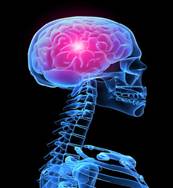
YOGA AND MIGRAINE
The headaches typically begin in adolescence or early adulthood, but onset may be earlier or later in some cases. There is clustering in families, suggesting a genetic component. Scientists also think that imbalances in brain chemicals such as serotonin and magnesium may trigger Migraine attack. Fluctuation in estrogen and progesterone also seem to cause Migraine attack in Women. Modify your lifestyle such that you get complete freedom from the tensions in your life. Pressure on brain should be minimized. It is almost impossible to change the lifestyle, but you may try to get adjusted to the better side of your life. The prevention of a migraine attack is by trying to identify any precipitating factor and avoiding the same. Avoiding alcohol, smoking and controlling hypertension is also essential. The use of counselling and psychotherapy is essential in highly stressed, nervous and emotional individuals.
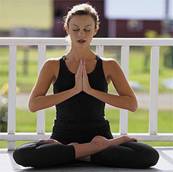
YOGA POSES FOR MIGRAINE
Lotus Yoga Pose
The Lotus Yoga Pose is usually done in Meditation. It is a classic seated posture which strengthens your ankles and knees, enhances concentration, and improves flexibility of your legs.
Bow pose
The alternating stretching and releasing of the abdominal muscles increases blood flow to this area and aids all sorts of digestive disorders and discomforts. The Bow works all parts of your back simultaneously. The pose is so named because as you hold it, your body is bent back like a bow and your arms are held straight and taut like a bowstring.
Spinal Twist Pose
The whole abdominal organs are properly toned and stimulated well by the increase of intra-abdominal pressure. Sluggishness of liver or hepatic torpidity disappears. It tones the bowels and removes constipation (ordinary, chronic and habitual). It awakens Kundalini.The important physiological aspects of this posture (asana) are that it stimulates the pancreas, liver, spleen, kidneys, stomach and ascending and descending colons.
Boat Pose
Perform the Boat Pose to strengthen your abdominal area and hip flexor, tone muscles in the midsection, improve digestion, and relieve stress. You can use a Yoga Strap to aid you in holding the pose longer or if you cannot keep your legs straight.
Tree Pose
The Tree Pose helps strengthen your thighs, calves, ankles and back. It can also increase the flexibility of your hips and groin. Your balance and concentration can also be improved with constant practice. This Yoga Pose is recommended for people who have sciatica and flat feet.
Legs up the Wall PoseLegs-Up-The-Wall pose (Viparita Karani) is a wonderful yoga position that few of us take the time to do and most of us need. Much of the yoga currently practiced here in the US is active and often very vigorous. Yoga stresses the importance of balancing these yang (active) poses with yin (passive) poses. Legs-Up-The-Wall pose fits the bill perfectly. It is a gentle inversion that helps to relieve the effects of stress by soothing the nervous system, increasing circulation and allowing the mind to calm. It is especially great for people who spend too much time sitting and standing since it relieves swelling and fatigue in the legs and feet by reversing the effects of gravity.
Child Pose
The Child Pose is a gentle way of stretching your shoulders, hips, thighs, ankles, and back muscles. It is a relaxation posture which is done to normalize the circulation after performing the Headstand and to serve as counterpose after Backbends.
YOGA ASANAS FOR MIGRAINE
JANUSIRSASANA
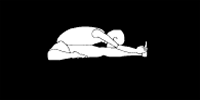
Janu means knee and sirsa means the head. Asana means pose in Sanskrit. It is a pose to enjoy asymmetry. The potential is to free up constriction in different parts of the back and to loosen the hamstrings.
Steps
• Sit on the floor with your buttocks lifted on a folded blanket and your legs straight in front of you. Inhale, bend your right knee, and draw the heel back toward your perineum. Rest your right foot sole lightly against your inner left thigh, and lay the outer right leg on the floor, with the shin at a right angle to the left leg (if your right knee doesn't rest comfortably on the floor, support it with a folded blanket).
• Press your right hand against the inner right groin, where the thigh joins the pelvis, and your left hand on the floor beside the hip. Exhale and turn the torso slightly to the left, lifting the torso as you push down on and ground the inner right thigh. Line up your navel with the middle of the left thigh. You can just stay here, using a strap to help you lengthen the spine evenly, grounding through the sitting bones.
• When you are ready, you can drop the strap and reach out with your right hand to take the inner left foot, thumb on the sole. Inhale and lift the front torso, pressing the top of the left thigh into the floor and extending actively through the left heel. Use the pressure of the left hand on the floor to increase the twist to the left. Then reach your left hand to the outside of the foot. With the arms fully extended, lengthen the front torso from the pubis to the top of the sternum.
• Exhale and extend forward from the groins, not the hips. Be sure not to pull yourself forcefully into the forward bend, hunching the back and shortening the front torso. As you descend, bend your elbows out to the sides and lift them away from the floor.
• Lengthen forward into a comfortable stretch. The lower belly should touch the thighs first, the head last. Stay in the pose anywhere from 1 to 3 minutes. Come up with an inhalation and repeat the instructions with the legs reversed for the same length of time.
JALANDHARABANDHA
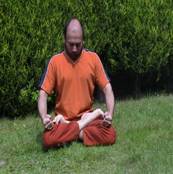
The meaning of the word Jalandhar, " Jal " means " Net ", in this case, net of Nadis (energy channels) and the word " Dhar " means to stop or to hold the flow of the fluid (Amrut), flowing through the nadis.This exercise is known to be the "destroyer of old age." You can do this exercise in any yoga posture, though most people prefer to be in Padmasana or lotus posture to do this exercise. In this posture, the neck is bent a little to do the 'bandh'. In this all the muscles of the neck and throat are contracted and a force is exerted on the seven paths of the throat.
Steps
• Sit in a comfortable pose.
• Firm your shoulder blades against your back torso to lift your sternum. Be careful not to push your front ribs forward.
• Full Jalandhara requires the chin to rest comfortably on the sternum (neck flexion). Many beginners make the mistake of only lowering the chin; in fact your chin should be met half-way by the elevated sternum.
• The focus of these complementary movements is the "crook" of the throat, where the underside of the chin meets the front of the neck. Draw this crook diagonally up and into your skull (toward the top of your spine).Your head should pivot and your chin should descend over this action, which simultaneously draws the top of the sternum upward.
• Work on lengthening the back of your neck, releasing your shoulders, and opening your chest in poses like Sarvangasana and Setu Bandha Sarvangasana. Never force your chin to your sternum.
• If you're a beginner, don't hold this bandha continuously throughout your practice. Begin your inhalation with your head upright. Apply Jalandhara as you near the end of the inhale, hold during the retention and the exhale, and then raise your head to a neutral position for the next inhale.
SARVANGASANA
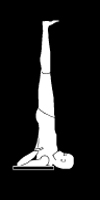
It brightens the psychic faculties and awakens Kundalini Sakti, removes all sorts of diseases of intestine and stomach, and augments the mental power. It supplies a large quantity of blood to the roots of spinal nerves. The muscles of the abdomen, the rectic muscles and the muscles of the thigh are also toned and nourished well. Obesity or corpulence and habitual chronic constipation, Gulma, congestion and enlargement of the liver and spleen are cured by this Asana.
Steps
• Lie on the back quite flat. Slowly raise the legs.
• Lift the trunk, hips, and legs quite vertically. Support the back with the two hands, one on either side. Rest the elbows on the ground. Press the chin against the chest.
• Allow the back-shoulder portion and neck to touch the ground closely. Do not allow the body to shake or move to and fro. Keep the legs straight.
• When the Asana is over, bring the legs down very, very slowly with elegance and not with any jerks.
• In this Asana the whole weight of the body is thrown on the shoulders. You really stand on the shoulders with the help and support of the elbows.
• Retain the breath as long as you can do with comfort, and slowly exhale through the nose.
VIPARITAKARANI
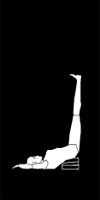
Steps
• Place a bolster or two folded blankets about 2 inches away from the wall
• Sit sideways on the bolster so your right hip and side are touching the wall. With the bolster under your bottom, lower yourself back, using the support of your elbows and forearms, and swivel around to take your right leg and then your left leg up the wall.
• Stay in the pose for 10 minutes or longer. If you are tired, it is natural to fall asleep in this pose.
• When you are ready to come out, bend your knees, turn to your side, and relax on the floor for a few more breaths before you slowly sit up.
PASCHIMOTTANASANA
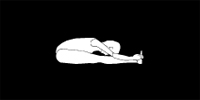
The literal translation of Paschimottanasana is intense stretch-of-the-west.Paschimottanasana (Seated Forward Bend) is a mainstay of an asana practice. The pose stretches the spine, hamstrings and shoulders, encourages the free flow of the breath and stimulates the liver and kidneys. As a deep forward bend, paschimottanasana encourages relaxation, calms anxiety and teaches us to work with the breath; the soft exhaling breath should be used to ease gently into the pose.
Steps
• This posture involves stretching of the posterior muscles of the body.
• While sitting, stretch your legs forward and keep them close to each other. Bend a little forward, make hooks of your fingers and hold the big toes on the respective sides.
• While exhaling, bend forward stretching the trunk along the thighs. Rest your on the knees, which should be kept straight.
• Gradually, the tense muscles can be made supple for securing the complete posture. Inhale and return to the original position
SETUBANDHASANA
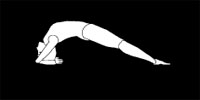
Supported Bridge Pose helps regulate and balance blood pressure. Women are more prone to elevated blood pressure when the protective effect of estrogen is withdrawn. As you stay in the pose, feel the effect deep inside the whole belly area. The effect of dropping the belly, uterus and ovaries in the pelvic bowl helps to balance the hormonal secretions and thus helps ease the hormonal fluctuations of menopause.
Steps
• Lie down in Shavasana posture. Raise your knees and bring your feet nearer to the hips keeping them apart. Keep your hands near the thighs.
• While inhaling, raise your hips and hands upwards simultaneously. Keep your hands over your head on the floor.
• back your hands and hips to the original position while exhaling. Repeat three to four times and relax.
• When you are ready to come out, bend your knees, turn to your side, and relax on the floor for a few more breaths before you slowly sit up.
ASTROLOGY
Yoga is the primary level which consists of bodily exercises to build a ground for Meditation. The word yoga had been derived from the Sanskrit word yuj which means to join to unite to balance or to integrate. Yoga is a system of exercises for the mental and physical well being. It combines stylized poses with deep meditation and breathing. According to astrological reports for yoga asanas the above mentioned asanas are said to be effective for those who come under the following zodiac sign.
• ARIES
• GEMINI
• AQUARIUS